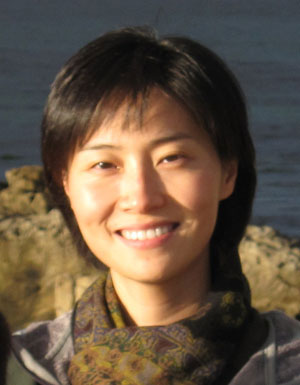
Xiang-Lei Yang, Ph.D.

Xiang-Lei Yang is a Professor of Chemical Physiology at The Scripps Research Institute. In the Schimmel-Yang laboratory, she leads the effort on elucidating the mechanism of the functional diversity of human aminoacyl-tRNA synthetases and understanding how different functions are activated and regulated.
Known as an essential component of the translational apparatus, aminoacyl-tRNA synthetase family catalyzes the first step reaction in protein synthesis, that is, to specifically attach each amino acid onto its cognate tRNA. While preserving this essential role, tRNA synthetases develop other roles during evolution. Human tRNA synthetases, in particular, have diverse functions in various pathways involving angiogenesis, inflammation and apoptosis. The functional diversity is further illustrated in the association with various diseases through genetic mutations on tRNA synthetases that do not affect aminoacylation or protein synthesis.
After solving the crystal structures of two human tRNA synthetases that having opposing functions in regulating angiogenesis upon activation, Dr. Yang established the structural basis for cytokine activation, and developed a new molecule with constitutive cytokine activity that is in pre-clinical development for treating angiogenesis-related human diseases.
Dr. Yang and her colleagues have elucidated the fundamental reason for a tRNA synthetase to be selected for inhibiting angiogenesis. The in-depth understanding of the mechanism has provided insight for optimizing the molecule for treating cancer malignancies whose growths rely on angiogenesis.
Up to date, Dr. Yang and her colleagues have solved crystal structures of four different human tRNA synthetases, including the two tRNA synthetases that are genetically linked to a common peripheral neuropathy Charcot-Marie-Tooth disease. Her laboratory proposed the connection of disease phenotype to the dimer interface of a tRNA synthetase. As many gene products involved with Charcot-Marie-Tooth disease form dimers, a general connection might be made between peripheral neuropathy and the dimer interface. The laboratory is continuing to develop this concept.
Dr. Yang is the author or co-author of 34 scientific publications and the inventor of one patent. She has given 32 invited lectures at international conferences, universities, pharmaceutical companies and venture capital groups around the world. She is the scientific co-founder and advisor of aTyr Pharma, which is aimed at developing tRNA synthetase-related molecules as therapeutic biologics.
Dr. Yang received her B.S. in Biomedical Engineering from Capital Institute of Medical Science (Beijing), and her Ph.D. in Biophysics and Computational Biology from University of Illinois at Urbana-Champaign. She was previously a postdoctoral fellow and an assistant professor at The Scripps Research Institute.
Selected Publications:
Zhou, Q., Kapoor, M., Guo, M., Belani, R., Xu, X., Kiosses, W.B., Hanan M., ParK, C., Armour, E., Do, M.-H., Nangle, L. A., Schimmel, P. and Yang, X.-L.* (2009) Orthogonal use of a human tRNA synthetase active site to achieve multi-functionality. Nat. Struc. Mol. Biol. In press (*Corresponding author)
Guo, R-T., Chong Y.E., Guo M. and Yang, X.-L.* (2009) Crystal Structures and Biochemical Analyses Suggest Unique Mechanism and Role For Human GlyRS in Ap4A Homeostasis , J. Biol. Chem. 284, 28968-28976 (*Corresponding author)
Kapoor, M., Otero, F. J., Slike, B. M., Ewalt, K. L., and Yang, X.-L.* (2009) Mutational separation of aminoacylation and cytokine activities of human tyrosyl-tRNA synthetase. Chem. Biol. 16, 531–539 (*Corresponding author)
Guo, M., Ignatov, M., Musier-Forsyth, K., Schimmel, P. & Yang, X.-L.* (2008) Crystal structure of tetrameric form of human lysyl-tRNA synthetase: Implications for multisynthetase complex formation. Proc. Natl. Acad. Sci. U S A 105, 2331-2336 (*Corresponding author)
Yang, X.-L.*, Kapoor, M., Otero, F.J., Slike, B. Tsuruta, H., Frausto, R., Bates, A., Ewalt, K.L., Cheresh, D.A. & Schimmel, P. (2007). Gain-of-function mutational activation of human tRNA synthetase procytokine, Chem. Biol. 14, 1323-1333 (*Corresponding author)
Nangle, L.A., Zhang, W., Xie, W., Yang, X.-L.* & Schimmel, P. (2007). Charcot-Marie-Tooth disease-associated mutant tRNA synthetases linked to altered dimer interface and neurite distribution defect, Proc. Natl. Acad. Sci. U S A 104, 11239-11244 (*Co-corresponding author)
Xie, W., Nangle, L.A., Zhang, W., Schimmel, P. & Yang, X.-L.* (2007). Long-range structural effects of a Charcot-Marie-Tooth disease-causing mutation in human glycyl-tRNA synthetase, Proc. Natl. Acad. Sci. U S A 104, 9976-9981 (*Co-corresponding author)
Yang, X.-L.*, Guo, M., Kapoor, M., Ewalt, K.L., Otero, F.J., Robert J. Skene, R.J., McRee, D.E. & Schimmel, P. (2007). Functional and crystal structure analysis of active site adaptations of a potent anti-angiogenic human tRNA synthetase, Structure 15, 793-805 (*Corresponding author)
Yang, X.-L.*, Otero, F. J. , Ewalt, K. L., Liu, J., Swairjo, M. A., Kohrer, C., RajBhandary, U. L., Skene, R. J., McRee, D. E. & Schimmel, P. (2006). Two conformations of a crystalline human tRNA synthetase-tRNA complex: implications for protein synthesis, EMBO J. 25, 2919-2929 (*Corresponding author)
Yang, X.-L., Schimmel, P. & Ewalt, K. L. (2004). Relationship of two human tRNA synthetases used for cell signaling, Trends Biochem. Sci. 29, 250-256
Yang, X.-L., Otero, F. J. , Skene, R. J., McRee, D. E., Schimmel, P. & Ribas de Pouplana, L.(2003). Crystal structures that suggest late development of genetic code components for differentiating aromatic side chains, Proc. Natl. Acad. Sci. U S A 100, 15376-15380
Yang, X.-L., Skene, R. J., McRee, D. E. & Schimmel, P. (2002). Crystal structure of a human aminoacyl-tRNA synthetase cytokine, Proc. Natl. Acad. Sci. U S A 99, 15369-15374

